Navigation and Chart work - Handbearing Compasses
Selection of targets
Before selecting the points for a 3-point fix (a fix made up of 3 position lines), there are several things to consider.
- Are they on the chart? That really big chimney may be beyond the edge of your chart.
- Can you identify them for certain? (Take care with churches and water towers)
- What is the angle between them? (60° or 120° are optimum, more than 30° will just about do)
- How far away are they? (if a long way off, a small error in the bearing will become a large error by the time it is plotted)
- Which order should you take the bearings? (if the boat is moving, the bearings ahead and astern will change the least and should be taken first). Taking the bearings works best it you have an assistant to record the bearings as you take them. This way you will be able to take the fix quickly.
- If you are in an enclosed area or have islands around you it is easy to take bearings that are directly opposite and may not cross.
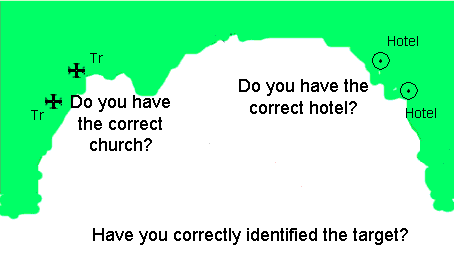
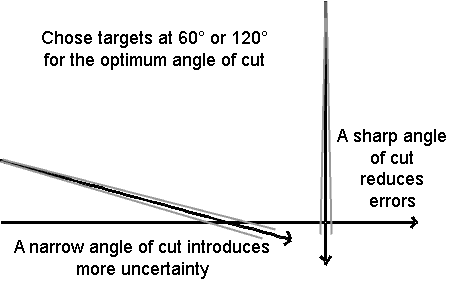
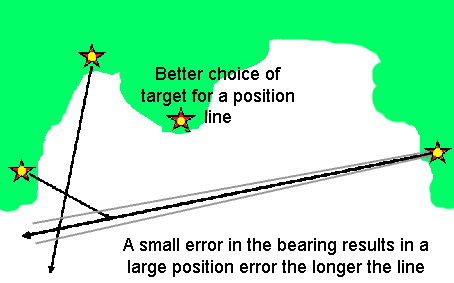
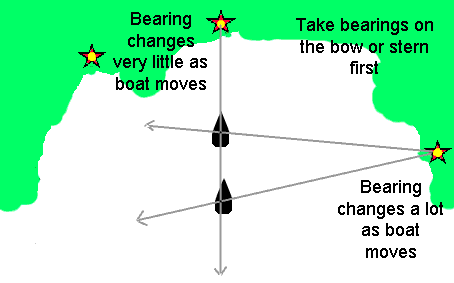
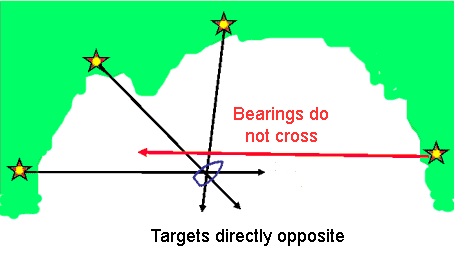
Handbearing compasses
There are several types of compass available:
Fluxgate compasses are electronic and have an easily read
scale with
large figures, so they are good for people with poor eyesight, and they have a memory so you do not need to write the bearings down. They
need to be kept level when used, as a small tilt up or down can
alter the bearings. You also need to carry a spare battery!
"Puck" type, these are small units which you can keep hung
around your 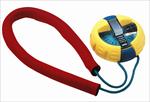 neck. They are by far the most popular on yachts, they are small enough that you can wear them round your neck and not notice they are there. As with all equipment they take a little time to
learn to use effectively, especially in rough weather!
neck. They are by far the most popular on yachts, they are small enough that you can wear them round your neck and not notice they are there. As with all equipment they take a little time to
learn to use effectively, especially in rough weather!
Large compasses on a handle. The previous two have mainly
superseded these. The best of these are the most accurate and robust compasses available. If they have a large display they may be of
use to someone with poor eyesight, but as they can not be kept
on a cord around the neck, or in a pocket they are difficult to
use on a small vessel.
these. The best of these are the most accurate and robust compasses available. If they have a large display they may be of
use to someone with poor eyesight, but as they can not be kept
on a cord around the neck, or in a pocket they are difficult to
use on a small vessel.
Any handbearing compass must have a light or some means of reading it in the dark. Some of the cheaper units have illumination that you need to "charge up" by holding them under a light source for a while.
If you hang your hand bearing compass round your neck for convenience, take care that the prism on the top is not chipped by coming in to contact with the metal parts of your safety harness or life jacket, I have damaged a few like this over the years.
Frequently when I run practical courses, students discover that they can not use a handbearing compass, especially at night, because they can not focus on the compass and the horizon at the same time. It is vital that you practice with a compass and find one that works for you, the last time to discover your eye sight is deteriorating is when trying to enter an unfamiliar harbour at night. The other option is to make sure you have at least one young crew member who's eyes you can rely on.
The first time I realised I needed to wear glasses was at the end of a sunny day whilst teaching hill walking to a group of children, I suddenly found that I could not focus on the map and the symbols were impossible to read. Fortunately I was able to use it as a teaching exercise and get the group to complete the rest of the day's navigation.
Chartering
Because handbearing compasses are often "lost", many charter vessels do not have them and anyone chartering a yacht should take their own one with them.
Additional Resources:

